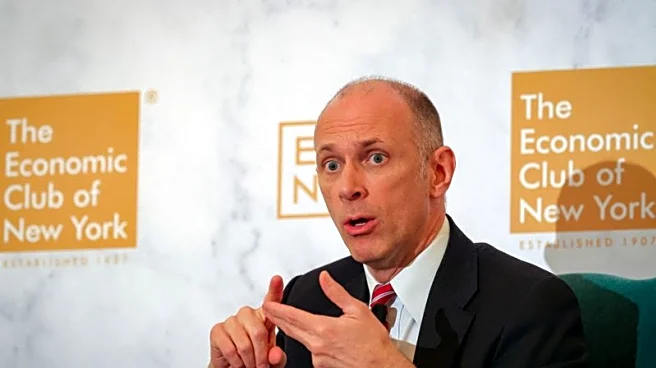What's Happening?
The U.S. Federal Reserve is expected to cut interest rates at its upcoming September meeting, with markets pricing in a 92.1% probability of this action. This anticipated move comes as inflation shows signs of easing, with the Consumer Price Index (CPI) for July rising 2.7% year-over-year, a cooler-than-expected figure. The potential rate cut would mark the first of the year, signaling a shift in monetary policy after a period of elevated rates aimed at combating inflation. Mortgage rates have already begun to respond, with the 30-year fixed-rate mortgage averaging 6.66%, down from 6.70% the previous week. Despite mixed economic data, including a hotter-than-expected wholesale inflation report, the broader economic picture supports a rate cut, with a slowing labor market and lower-than-expected inflation growth providing room for the Federal Open Market Committee (FOMC) to ease monetary policy.
Why It's Important?
A potential rate cut by the Federal Reserve is significant as it could influence various sectors of the U.S. economy. Lower borrowing costs are generally favorable for riskier assets, including tech stocks and cryptocurrencies, which have experienced volatility due to high interest rates. Additionally, mortgage shoppers could benefit from lower rates, providing an opportunity for homebuyers to secure better deals. The anticipated rate cut reflects a broader shift in the Fed's policy stance, balancing the need to control inflation with the goal of supporting economic growth. This decision could mark a turning point in the current rate-hiking cycle, impacting financial markets and economic stakeholders.
What's Next?
The Federal Reserve's decision on interest rates will be closely watched, with each new economic data release influencing market sentiment. Investors are particularly attentive to signals from the FOMC ahead of its September meeting. Mortgage lenders may continue to adjust rates in anticipation of the Fed's decision, potentially easing rates further before the official announcement. Analysts suggest that a 25-basis-point reduction would align with market expectations, supporting economic growth without undermining inflation control efforts.
Beyond the Headlines
The anticipated rate cut could have deeper implications for the U.S. economy, including potential shifts in investment strategies and consumer behavior. As borrowing costs decrease, businesses may find it easier to finance expansion projects, potentially boosting economic activity. Additionally, the decision could influence global markets, as changes in U.S. monetary policy often have international repercussions. The Fed's approach to balancing inflation control with economic growth will continue to be a critical factor in shaping future policy decisions.












